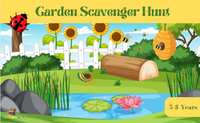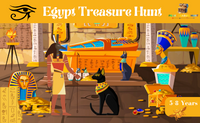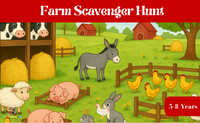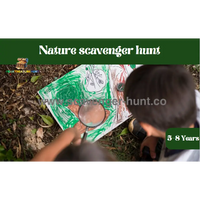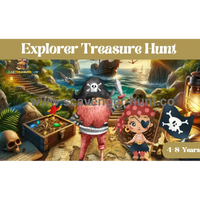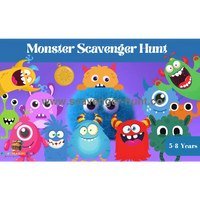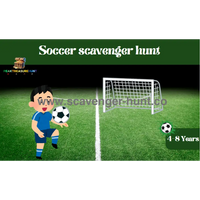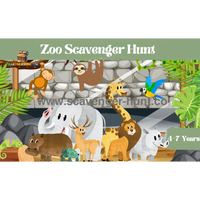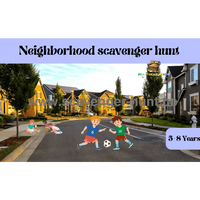Welcome to the wild and wonderful world of zoo scavenger hunts! If you're looking for an engaging, educational, and downright fun activity for kids, a scavenger hunt at the zoo is the perfect choice. It combines the thrill of discovery with the joy of learning about animals. Plus, it’s an excellent way to explore the zoo in a structured yet exciting way.
What is a Zoo Scavenger Hunt?
A zoo scavenger hunt is a playful and interactive activity where kids receive a list of animals they need to find in the zoo. This list is often presented on a PDF sheet, featuring pictures and names of various animals. The goal is for the kids to spot each animal during their visit, and tick the circle next to each one when they find it.
Preparing for the Hunt
Embarking on a zoo scavenger hunt is an exciting and educational adventure for kids. To ensure a successful and enjoyable experience, thorough preparation is key. In this chapter, we’ll cover all the essential steps to get ready for the big day, from creating scavenger hunt sheets to assembling necessary materials. Let’s dive into the details to make sure you and your group are well-prepared for a fun-filled hunt at the zoo.
Creating the Perfect Scavenger Hunt Sheet
The scavenger hunt sheet is the cornerstone of your adventure. It guides the kids through the zoo, helping them identify and learn about various animals. Here’s how to create an effective scavenger hunt sheet:
-
List of Animals: Start by compiling a list of animals that can be found at the zoo you’ll be visiting. Include a mix of common favorites (like lions, tigers, and elephants) and lesser-known animals to keep things interesting.
-
Images and Names: For each animal, include a clear, colorful image and the animal’s name. This helps kids quickly recognize and identify the animals during the hunt.
-
Fun Facts: Add a small box with interesting facts about each animal. For example, you could include information about their habitat, diet, or unique behaviors. This adds an educational element to the activity.
-
Check Boxes: Next to each animal, include a circle or box that kids can tick off once they’ve spotted the animal. This provides a sense of accomplishment and keeps track of their progress.
-
Customizable Templates: If creating your own sheet seems daunting, many websites offer printable scavenger hunt templates that you can customize based on the animals in your chosen zoo.
Once your scavenger hunt sheet is ready, print enough copies for each child. It’s a good idea to print a few extra in case any get lost or damaged during the day.
Essential Materials for the Hunt
In addition to the scavenger hunt sheets, there are a few other materials you’ll need to ensure a smooth and enjoyable hunt:
-
Clipboards: Provide each child with a clipboard. This gives them a sturdy surface to write on as they move around the zoo. Clipboards also help keep the scavenger hunt sheets organized and prevent them from getting crumpled or lost.
-
Pencils or Markers: Equip the kids with pencils or markers for ticking off the animals they find. Pencils are great because they can be erased if mistakes are made, but colorful markers can make the activity more vibrant and fun.
-
Backpacks or Bags: Encourage the kids to bring small backpacks or bags to carry their scavenger hunt sheets, pencils, water bottles, and any other personal items. This keeps their hands free and ensures they don’t lose anything important.
-
Comfortable Clothing and Footwear: Since you’ll be walking around the zoo for several hours, make sure everyone wears comfortable clothing and sturdy shoes. Check the weather forecast and dress accordingly – hats and sunscreen for sunny days, and raincoats or umbrellas if there’s a chance of rain.
-
Water and Snacks: Zoos can be large, and all that walking can be tiring. Bring plenty of water to stay hydrated and pack some healthy snacks to keep energy levels up. Many zoos have picnic areas where you can take a break and enjoy a snack.
-
First Aid Kit: It’s always a good idea to have a small first aid kit on hand. Include band-aids, antiseptic wipes, and any other basic supplies you might need in case of minor injuries.
Preparing the Kids
To make the scavenger hunt as smooth and enjoyable as possible, spend a little time preparing the kids before you arrive at the zoo. Here are some tips:
-
Explain the Rules: Go over the rules of the scavenger hunt with the kids. Emphasize the importance of staying together, respecting the animals and zoo rules, and being considerate of other visitors.
-
Assign Buddies: If you’re going with a large group, pair the kids up with buddies. This promotes teamwork and ensures no one gets left behind or lost.
-
Set Expectations: Let the kids know what to expect during the hunt. Explain that some animals might be harder to find than others and that it’s okay if they don’t find every animal on the list. The goal is to have fun and learn.
-
Encourage Questions: Encourage the kids to ask questions about the animals they see. This fosters curiosity and makes the experience more interactive and educational.
-
Safety Briefing: Brief the kids on basic safety rules, such as not climbing on fences, staying within designated paths, and listening to the adults in charge.
The Night Before
The night before your zoo visit, do a final check to make sure you have everything you need. Pack the scavenger hunt sheets, clipboards, pencils, and any other materials into a bag. Ensure the kids’ backpacks are ready with water bottles, snacks, and comfortable clothing.
Get a good night’s sleep so everyone is well-rested and ready for an exciting day at the zoo. With everything prepared and organized, you’re all set for a fantastic scavenger hunt adventure!
⬇️⬇️⬇️⬇️DISCOVER OUR ZOO SCAVENGER HUNTS!!⬇️⬇️⬇️⬇️


Setting Off on the Adventure
The day has finally arrived – it’s time for your zoo scavenger hunt adventure! With all your preparations complete, you’re ready to head out and explore the wonders of the animal kingdom. This chapter will guide you through the first steps of your adventure, from gathering the kids and setting the rules, to navigating the zoo and making the most of your scavenger hunt experience. Let’s dive in!
Gathering the Kids and Setting the Rules
As you arrive at the zoo, excitement will be running high. Before you start your scavenger hunt, gather the kids together to explain the rules and set the tone for the day. Here are the key points to cover:
-
Stay Together: Safety is the top priority. Emphasize the importance of sticking together as a group. Explain that everyone should stay within sight of the adults and each other. Assign buddies if you have a larger group to help ensure no one gets separated.
-
Respect the Animals: Zoos are home to many different animals, each with their own needs and behaviors. Remind the kids to be quiet and calm around the animals, avoiding any sudden movements or loud noises that could startle them. Encourage them to observe and appreciate the animals without disturbing them.
-
Check Off Each Animal: Explain how the scavenger hunt sheets work. As soon as they spot an animal on their list, they can tick the circle next to it on their sheet. This keeps the activity organized and helps track their progress throughout the day.
Starting the Hunt
With the rules explained and everyone on the same page, it’s time to start the scavenger hunt. Follow these steps to make the beginning of your adventure smooth and enjoyable:
-
Enter the Zoo and Get a Map: As you enter the zoo, pick up a map if you don’t already have one. The map will be your guide, helping you navigate to the different animal exhibits and ensuring you don’t miss any must-see animals on your list.
-
Choose a Starting Point: Decide on a logical starting point based on the layout of the zoo and the animals you want to see first. Many zoos have a suggested route or path that leads visitors through the exhibits in a logical order.
-
Check the Schedule: Some animals might have specific feeding times or keeper talks scheduled throughout the day. Check the zoo’s schedule and plan your route accordingly to catch these events, as they can be both informative and entertaining.
Navigating the Zoo
As you make your way through the zoo, keep the scavenger hunt exciting and educational by following these tips:
-
Engage with the Exhibits: Encourage the kids to spend time observing each animal, not just ticking them off the list. Ask questions about what they see – How does the animal move? What does it eat? How does it interact with its environment?
-
Use the Map: Teach the kids how to use the zoo map to find their way to different exhibits. This helps develop their navigation skills and gives them a sense of direction.
-
Take Photos: If possible, bring a camera or use your phone to take photos of the animals you find. This adds an extra layer of fun and provides lasting memories of the adventure.
-
Discuss Animal Facts: Use the fun facts on your scavenger hunt sheet as conversation starters. Discussing these facts helps reinforce learning and keeps the kids engaged.
-
Stay Flexible: While it’s good to have a plan, be flexible and open to changing your route if needed. Sometimes the most memorable experiences come from unexpected discoveries.
Making the Most of Breaks
Exploring the zoo can be tiring, especially for younger children. Plan to take breaks throughout the day to rest, hydrate, and recharge:
-
Snack and Hydration Breaks: Find a picnic area or a shady spot to sit down for a snack and a drink. This gives everyone a chance to rest their feet and refuel for the next part of the adventure.
-
Interactive Zones: Many zoos have interactive zones or play areas where kids can burn off some energy. These are great places to take a break and let the kids have some free playtime.
-
Review Progress: During breaks, review the scavenger hunt sheets with the kids. Celebrate the animals they’ve found so far and discuss the ones they still need to find. This helps keep the excitement and motivation high.
Ending the Hunt
As the day draws to a close, it’s time to wrap up your scavenger hunt and reflect on the adventure:
-
Gather the Group: Bring everyone together and find a quiet spot to sit and review their scavenger hunt sheets. Celebrate the completion of the hunt and the efforts of each child.
-
Share Experiences: Encourage the kids to share their favorite moments and discoveries from the day. This reflection helps reinforce what they’ve learned and allows them to relive the excitement.
-
Collect Souvenirs: Consider visiting the zoo’s gift shop to pick up a small souvenir. Whether it’s a stuffed animal, a postcard, or a book about animals, a souvenir can help keep the memory of the adventure alive.
-
Thank the Zoo Staff: If possible, take a moment to thank the zoo staff for their hard work and dedication to caring for the animals. This gesture teaches kids the importance of gratitude and respect for those who help make their adventures possible.
The Hunt Begins
With the rules set and excitement buzzing, it’s time to dive into the heart of your zoo scavenger hunt. As you embark on this adventure, every step through the zoo brings a new opportunity for discovery and learning. Here’s how to make the most of your scavenger hunt, ensuring it’s both enjoyable and educational for the kids.
Follow a Map
A zoo can be a vast place, and having a map is crucial for navigating efficiently. Here’s how to use the map to enhance your scavenger hunt:
-
Navigation Skills: Show the kids how to read the zoo map. Point out key landmarks, animal exhibits, restrooms, and snack areas. This not only helps you find your way but also teaches them valuable map-reading skills.
-
Plan Your Route: Based on the animals on your scavenger hunt sheet, plan a logical route that allows you to see as many animals as possible without backtracking. This saves time and energy, making the hunt more enjoyable.
-
Highlight Key Exhibits: Identify must-see exhibits on the map. These might include popular animals or special exhibits with educational displays. Highlighting these areas ensures you don’t miss any major attractions.
Ask Questions
Encouraging curiosity and learning is a big part of the scavenger hunt experience. Here’s how to foster an inquisitive mindset:
-
Observe and Discuss: As you arrive at each exhibit, take a moment to observe the animals. Ask the kids questions like, “What do you think this animal eats?” or “How does this animal move differently from others we’ve seen?” These questions prompt thoughtful observation and discussion.
-
Read Informational Signs: Most zoo exhibits have informational signs about the animals. Read these together and discuss interesting facts. For example, you might learn about an animal’s habitat, diet, or unique behaviors. This enriches the scavenger hunt with educational content.
-
Encourage Questions: Let the kids know it’s okay to ask any questions they have about the animals. If you don’t know the answer, you can look it up together later. This promotes a spirit of lifelong learning and curiosity.
Take Breaks
Zoos are often extensive, and walking around can be tiring, especially for younger children. Plan regular breaks to rest and recharge:
-
Snack and Hydration Breaks: Bring plenty of water and healthy snacks. Find a bench or a designated picnic area to sit down and take a break. Staying hydrated and fueled helps keep energy levels up and prevents fatigue.
-
Play Areas: Many zoos have play areas or interactive exhibits where kids can take a break from walking and have some fun. These areas provide a great opportunity for a rest while keeping the kids entertained.
-
Reflect and Review: Use break times to review the scavenger hunt sheets. Discuss which animals you’ve found so far and which ones are still on the list. This keeps the kids engaged and excited about the next part of the hunt.
Engaging with the Exhibits
As you move from one exhibit to the next, maintain the kids’ interest and engagement with these tips:
-
Interactive Zones: Some zoos have interactive exhibits where kids can touch or feed certain animals. These hands-on experiences are memorable and provide a deeper connection to the animals.
-
Photo Opportunities: Encourage the kids to take photos of the animals they find. This not only creates lasting memories but also helps them focus on observing the animals closely.
-
Animal Behaviors: Pay attention to the behaviors of the animals. Are they eating, sleeping, playing, or interacting with each other? Discuss these behaviors and what they might mean. This adds depth to the kids’ understanding of animal life.
Dealing with Challenges
Sometimes, finding every animal on the list can be a challenge. Here’s how to handle common obstacles:
-
Animal Visibility: Some animals might be hiding or sleeping, making them hard to spot. Explain to the kids that it’s normal for animals to rest or seek shelter. Encourage patience and quiet observation.
-
Crowds and Noise: Popular exhibits can be crowded. Teach the kids to be respectful of other visitors and to wait patiently for a good view. This promotes good manners and patience.
-
Unexpected Changes: Zoos sometimes change their exhibits or move animals. If an animal on your list is not available, use it as a learning opportunity. Discuss why the animal might not be there and what the zoo does to take care of its residents.
Wrapping Up the Hunt
As you near the end of your scavenger hunt, start wrapping up the experience in a way that reinforces learning and celebrates the day’s achievements:
-
Final Review: Gather the kids and review the scavenger hunt sheets together. Celebrate the animals they found and discuss any that were particularly interesting or surprising.
-
Share Highlights: Encourage each child to share their favorite part of the day. This reflection helps reinforce their learning and gives them a chance to express their excitement.
-
Thank the Kids: Acknowledge the kids’ efforts and enthusiasm. Thank them for participating and for their respectful behavior towards the animals and other zoo visitors.
-
Collect Souvenirs: If time allows, visit the zoo gift shop for a small souvenir to remember the day. Whether it’s a stuffed animal, a postcard, or a book, a souvenir can keep the memories of the adventure alive.
Highlights of the Scavenger Hunt
As you make your way through the zoo, you'll encounter many incredible animals, each with its own unique characteristics and behaviors. These encounters will be the highlights of your scavenger hunt, providing excitement and memorable learning opportunities for the kids. Let’s explore some of the most thrilling animal encounters you’re likely to experience during your adventure.
Elephant Encounter
One of the most awe-inspiring moments of any zoo visit is watching the majestic elephants. These gentle giants captivate kids and adults alike with their size, grace, and intelligence. Here’s how to make the most of your elephant encounter:
-
Spotting Elephants: Elephants are often easy to spot due to their large size. Look for them in spacious enclosures that mimic their natural habitats, complete with trees, water holes, and plenty of space to roam.
-
Trunk Behavior: Elephants use their trunks for a variety of tasks, from eating and drinking to playing and social interactions. Encourage the kids to observe how the elephants use their trunks to grab food, spray water, or interact with each other.
-
Social Structure: Discuss the social structure of elephants. Explain how they live in family groups, led by a matriarch, and how they communicate with each other through sounds and body language.
-
Conservation Message: Use this opportunity to talk about elephant conservation. Discuss the challenges elephants face in the wild, such as habitat loss and poaching, and what zoos are doing to help protect these magnificent animals.
Giraffe Gazing
Giraffes, with their long necks and unique patterns, are always a favorite among kids. Observing these gentle giants provides a wonderful opportunity to learn about their adaptations and behaviors:
-
Spotting Giraffes: Giraffes are usually easy to spot, towering over other animals with their long necks. Look for them in enclosures with tall trees and plenty of foliage.
-
Feeding Behavior: Giraffes use their long necks and prehensile tongues to reach leaves high up in trees. Encourage the kids to watch how the giraffes skillfully strip leaves from branches using their tongues.
-
Unique Patterns: Each giraffe has a unique pattern of spots, much like a human fingerprint. Point out the differences in their patterns and explain how these patterns help with identification and camouflage.
-
Movement and Grace: Watch the giraffes walk and run. Their movements are graceful despite their size. Discuss how their long legs and necks are perfectly adapted for life in the savannah.
Monkeying Around
Monkeys are some of the most playful and entertaining animals to observe. Their energetic behaviors and social interactions make them a highlight of any zoo visit:
-
Spotting Monkeys: Monkeys can often be found in dynamic enclosures with trees, ropes, and platforms. Look for them swinging from branches or interacting with each other.
-
Playful Behaviors: Monkeys are known for their playful nature. Encourage the kids to watch for behaviors like swinging, jumping, and playing with each other. These activities are not only fun to watch but also important for their social development.
-
Grooming: Grooming is a common social behavior among monkeys. It helps strengthen social bonds and keep their fur clean. Point out any grooming behavior and discuss its importance.
-
Communication: Monkeys use a variety of vocalizations, facial expressions, and body language to communicate. Listen for their calls and watch how they interact with each other.
Big Cats
Lions, tigers, and other big cats are always a highlight of a zoo visit. Their power, beauty, and grace are mesmerizing. Here’s how to make the most of your big cat encounters:
-
Spotting Big Cats: Big cats often have large, well-designed enclosures that mimic their natural habitats. Look for them lounging on rocks, hiding in the grass, or pacing along the fences.
-
Behavioral Observations: Observe how the big cats move, rest, and interact with their environment. Discuss their behaviors, such as stalking, grooming, and playing. Explain how these behaviors are similar to and different from those of domestic cats.
-
Feeding Times: If possible, plan to visit the big cat enclosures during feeding times. Watching a lion or tiger eat provides a fascinating glimpse into their natural hunting and feeding behaviors.
-
Conservation Topics: Use the opportunity to talk about the conservation status of big cats. Discuss the threats they face in the wild, such as habitat loss and poaching, and what efforts are being made to protect them.
Additional Highlights
While elephants, giraffes, monkeys, and big cats are major attractions, there are many other fascinating animals to discover during your scavenger hunt:
-
Birds of Prey: Visit the aviary to see majestic eagles, owls, and hawks. Discuss their hunting skills and the importance of their role in the ecosystem.
-
Reptile House: Explore the world of reptiles, from slithering snakes to sunbathing lizards. Highlight the unique adaptations that allow them to thrive in their environments.
-
Aquatic Animals: Don’t forget to visit the aquarium section, if your zoo has one. Marvel at the colorful fish, playful otters, and mysterious jellyfish. Discuss the diversity of life in aquatic ecosystems.
-
Insect Exhibits: Check out the insect exhibits to see fascinating creatures like butterflies, beetles, and ants. Explain
⬇️⬇️⬇️⬇️DISCOVER OUR ZOO SCAVENGER HUNTS!!⬇️⬇️⬇️⬇️


Learning and Fun Combined
While the primary goal of your zoo scavenger hunt is to find all the animals on your list, this adventure is rich with educational benefits that go beyond simply checking off boxes. As the kids engage in this fun activity, they will naturally develop a range of important skills and deepen their understanding of the animal kingdom. Let’s explore how this scavenger hunt combines learning and fun, and the valuable lessons the kids will gain along the way.
Observation Skills
The scavenger hunt is a fantastic way to enhance kids’ observation skills. As they search for different animals, they learn to pay close attention to their surroundings and notice details they might otherwise overlook. Here’s how:
-
Attention to Detail: Spotting animals in their enclosures requires kids to look carefully and distinguish between different shapes, colors, and movements. This sharpens their ability to notice and appreciate the subtleties in their environment.
-
Behavioral Observation: Encourage the kids to watch how animals behave. Are they active or resting? How do they interact with their environment and each other? These observations help kids understand that behavior can vary greatly among different species and even among individuals of the same species.
-
Use of Senses: Observing animals involves more than just looking. Encourage the kids to use their other senses too. Can they hear the animals’ sounds? What smells are present in different parts of the zoo? Engaging multiple senses enhances their overall observational skills.
Learning About Animal Behavior and Habitats
A zoo scavenger hunt is an immersive way to teach kids about animal behavior and habitats. As they find each animal, they learn valuable information about where and how these animals live:
-
Habitat Understanding: Zoos often recreate natural habitats for their animals. Discussing these habitats with the kids helps them understand where animals come from and what kinds of environments they need to thrive.
-
Behavioral Insights: Observing animals in the zoo allows kids to see a variety of behaviors, from feeding and grooming to playing and resting. Discuss why animals behave the way they do and how these behaviors help them survive in the wild.
-
Adaptations: Talk about the physical and behavioral adaptations that help animals live in their specific environments. For example, explain how a giraffe’s long neck helps it reach leaves high up in trees, or how a tiger’s stripes provide camouflage in the forest.
Fostering Teamwork and Cooperation
Working together to find all the animals on the scavenger hunt list is a great way to foster teamwork and cooperation among the kids:
-
Collaboration: Encourage the kids to work as a team, sharing responsibilities and helping each other find the animals. This teaches them the value of collaboration and the importance of working together towards a common goal.
-
Communication: Effective teamwork requires good communication. The kids will need to discuss their observations, share information about where they think animals might be, and listen to each other’s ideas and suggestions.
-
Problem-Solving: Sometimes, finding an animal on the list might be challenging. Encourage the kids to solve problems together, such as figuring out alternative routes or strategies for spotting elusive animals. This builds their problem-solving skills and resilience.
Developing Navigation Skills
Using the zoo map and following a planned route helps kids develop important navigation skills:
-
Map Reading: Teach the kids how to read the zoo map, including understanding symbols, labels, and directions. This helps them gain confidence in using maps and enhances their spatial awareness.
-
Planning and Execution: Following a planned route through the zoo involves planning ahead and sticking to a plan. This teaches kids the importance of organization and the ability to follow through on a plan.
-
Orientation: Navigating the zoo helps kids understand concepts like direction, distance, and landmarks. They learn to orient themselves in a new environment and find their way from one exhibit to another.
Encouraging Curiosity and Lifelong Learning
The scavenger hunt naturally sparks curiosity and a love for learning. Here’s how this experience encourages kids to continue exploring and learning:
-
Questioning: Encourage the kids to ask questions about everything they see. Why do certain animals live in specific habitats? How do they find food? This questioning mindset promotes continuous learning and curiosity.
-
Discovering New Interests: The diverse range of animals and exhibits in the zoo can inspire new interests and passions. A child who is fascinated by a particular animal might want to learn more about it after the visit, leading to further exploration and study.
-
Making Connections: Help the kids make connections between what they see at the zoo and what they’ve learned elsewhere. For example, relate the animals they see to stories, documentaries, or lessons they’ve encountered in school. This reinforces their learning and helps them see the broader context.
Wrapping Up the Adventure
After a day filled with exploration and excitement, it’s time to bring your zoo scavenger hunt to a satisfying close. Wrapping up the adventure thoughtfully is crucial for reinforcing what the kids have learned and celebrating their achievements. Here’s how to effectively conclude your scavenger hunt, ensuring it’s a memorable and educational experience for everyone involved.
Reviewing the Findings
Gathering the kids together to review their findings is a great way to solidify their learning and reflect on the day’s adventure. Here’s how to guide this reflective process:
-
Group Discussion: Bring the kids to a comfortable, quiet spot within the zoo or a designated picnic area. Gather them in a circle to create an inclusive and focused environment for discussion.
-
Show and Tell: Encourage each child to share their scavenger hunt sheets. Ask them to talk about the animals they found and what they observed. This gives them an opportunity to recount their experiences and reinforce their learning.
-
Favorite Animals: Discuss which animals were their favorites and why. This helps them reflect on their preferences and articulate their thoughts. It’s also a fun way to hear about the highlights from each child’s perspective.
-
Learning Points: Ask the kids what new things they learned about the animals they saw. This reinforces the educational aspects of the scavenger hunt and allows them to share interesting facts with each other.
Reflecting on the Experience
Reflection is a powerful tool for deepening understanding and creating lasting memories. Guide the kids through this process with thoughtful questions and activities:
-
Memory Sharing: Invite the kids to share their most memorable moment of the day. Whether it was watching a playful monkey, seeing a majestic lion, or observing the graceful movements of a giraffe, these memories are precious and worth sharing.
-
Learning Highlights: Ask the kids to think about what they learned that surprised them the most. This could be an unusual fact about an animal’s behavior, habitat, or physical characteristics. Sharing these surprising learnings helps solidify their knowledge.
-
Teamwork and Cooperation: Reflect on how they worked together during the scavenger hunt. Discuss the importance of teamwork, cooperation, and communication. Highlight any moments where they helped each other or solved problems together.
-
Personal Growth: Encourage the kids to think about any new skills they developed or improved during the scavenger hunt. This could include observation skills, map reading, or asking insightful questions.
Celebrating Achievements
Celebrating the kids’ achievements is an essential part of wrapping up the scavenger hunt. Recognizing their efforts boosts their confidence and makes the experience more rewarding:
-
Certificates and Awards: Prepare simple certificates or awards to hand out to each child. These can be for completing the scavenger hunt, showing great teamwork, or demonstrating excellent observation skills. Personalized awards make each child feel special.
-
Group Photo: Take a group photo to commemorate the day. This not only serves as a memento but also creates a sense of unity and accomplishment among the kids.
-
Souvenirs: If possible, visit the zoo’s gift shop for small souvenirs. Whether it’s a stuffed animal, a postcard, or a bookmark, these items help keep the memories of the day alive.
-
Snack Time: End the adventure with a celebratory snack or picnic. This provides a relaxed setting for the kids to unwind, share their experiences, and enjoy each other’s company.
Summarizing the Experience
Before you leave the zoo, take a moment to summarize the entire experience. This helps reinforce what the kids have learned and ensures they leave with a sense of accomplishment:
-
Recap the Day: Briefly go over the main highlights of the day. Mention the animals you saw, the interesting behaviors you observed, and any fun moments that stood out. This helps cement the day’s experiences in the kids’ memories.
-
Key Takeaways: Highlight the key educational points from the scavenger hunt. Discuss the importance of conservation, the fascinating adaptations of different animals, and the value of teamwork and observation skills.
-
Thank You Notes: Encourage the kids to write thank you notes to the zoo staff or volunteers who made the visit special. This teaches gratitude and acknowledges the effort that goes into maintaining the zoo and educating visitors.
A Souvenir to Remember
As your zoo scavenger hunt adventure comes to a close, consider ending the day with a visit to the zoo gift shop. Choosing a small souvenir can be a meaningful way to commemorate the experience, providing a tangible reminder of the fun and learning that took place. Here’s how to make selecting a souvenir an enjoyable and thoughtful part of your zoo visit.
The Importance of Souvenirs
Souvenirs play a significant role in keeping the memories of the adventure alive. They serve as physical tokens that remind kids of the day’s excitement and discoveries:
-
Memory Anchors: Souvenirs act as memory anchors, helping kids recall specific moments and feelings from the zoo trip. A stuffed animal might remind them of a favorite animal they saw, while a book can reinforce the facts they learned.
-
Educational Value: Many zoo gift shops offer educational items such as books, puzzles, and games that teach kids more about animals and conservation. These items extend the learning experience beyond the zoo visit.
-
Personal Connection: Allowing kids to choose their own souvenir fosters a personal connection to the experience. It becomes a cherished keepsake that holds special meaning for them.
Choosing the Right Souvenir
Selecting a souvenir can be a fun and engaging process. Here are some tips to help you and the kids make the best choice:
-
Guided Selection: Provide guidance by suggesting souvenirs that have educational value or are related to the animals and exhibits they enjoyed the most. Encourage the kids to choose something that reminds them of their favorite part of the zoo visit.
-
Budget-Friendly Options: Souvenirs don’t have to be expensive to be meaningful. Simple items like postcards, keychains, or small figurines can be just as special as larger, pricier items. Set a budget and help the kids find something within that range.
-
Personalization: Look for souvenirs that can be personalized. Many zoos offer items like custom name plaques, engraved keychains, or photo frames that can include a picture from the day.
-
Educational Souvenirs: Encourage the selection of educational items such as books about animals, puzzles depicting various species, or interactive toys that teach about wildlife. These items continue the learning experience at home.
Making the Purchase
The process of purchasing a souvenir can also be a learning opportunity:
-
Decision-Making: Guide the kids through the decision-making process. Discuss why they might choose one item over another, helping them weigh the pros and cons and make thoughtful decisions.
-
Money Management: If appropriate, use this as a chance to teach basic money management skills. Give the kids a specific amount of money to spend and help them understand the value of budgeting.
-
Gratitude and Politeness: Remind the kids to thank the shop staff and to be polite during the transaction. This teaches good manners and appreciation for the work that goes into running the gift shop.
Cherishing the Souvenir
Once the souvenirs are chosen and purchased, take a moment to appreciate them:
-
Show and Tell: Encourage the kids to show their souvenirs to the group and explain why they chose them. This sharing session helps them articulate their experiences and feelings about the day.
-
Connecting Memories: Discuss how the souvenir connects to their memories of the zoo visit. For example, if they chose a stuffed tiger, ask them to recall what they learned about tigers during the scavenger hunt.
-
Display and Use: Encourage the kids to display their souvenirs at home in a place where they can see them often. Books and educational toys can be incorporated into their daily activities, reinforcing their zoo experience.
Conclusion
A zoo scavenger hunt is an incredible way to make a trip to the zoo even more memorable and educational. It’s a fun-filled activity that encourages kids to explore, learn, and appreciate the animal kingdom. By preparing well, engaging in thoughtful observation, and reflecting on the experience, kids gain valuable skills and knowledge while having a great time.
Ending the day with a small souvenir from the zoo gift shop provides a lasting reminder of the adventure. Whether it’s a stuffed animal, a book about animals, or a simple postcard, a souvenir helps keep the memory of the day alive and continues the learning journey at home.
So, grab your scavenger hunt sheets, head to the zoo, and let the adventure begin! With curiosity and enthusiasm, explore the wonders of the animal world, make new discoveries, and create lasting memories that will inspire a lifelong love for wildlife and conservation.
Remember, the best part of a scavenger hunt is the journey, not just the destination. Happy Hunting!
⬇️⬇️⬇️⬇️DISCOVER OUR ZOO SCAVENGER HUNTS!!⬇️⬇️⬇️⬇️


Discover our Complete Scavenger Hunts Collection.


HOW TO PLAN A TREASURE HUNT FOR KIDS





